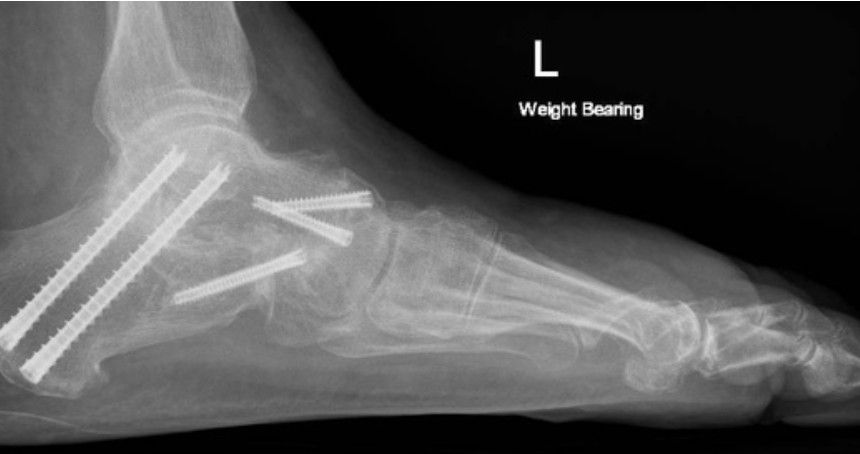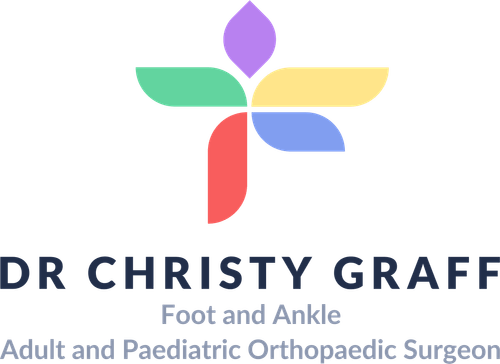Peroneal Tendon Conditions
What is Triple Arthrodesis?
Triple arthrodesis is a surgical procedure designed to relieve pain, improve stability, and correct deformities in the foot and ankle. It involves the fusion of three joints in the hindfoot:
- Subtalar Joint: Located below the ankle joint, it allows side-to-side foot motion.
- Talonavicular Joint: Found in the midfoot, it supports the arch movement.
- Calcaneocuboid Joint: Located near the outer edge of the foot, it helps with foot flexibility.
Fusing these joints eliminates movement between them, reducing pain and providing a stable foot structure. Triple arthrodesis is typically performed when nonsurgical treatments have failed to alleviate symptoms caused by severe arthritis, deformities, or instability.

Who is Suitable for Triple Arthrodesis?
Triple arthrodesis is suitable for individuals experiencing significant foot and ankle problems that interfere with daily life, such as:
- Chronic Pain: Severe pain from arthritis or joint degeneration.
- Deformities: Conditions like flatfoot, high arches, or clubfoot that impair mobility.
- Instability: Ligament damage or joint instability that makes walking difficult.
- Arthritis: Advanced arthritis due to trauma, inflammatory conditions, or wear and tear.
- Neurological Conditions: Disorders like Charcot-Marie-Tooth disease that affect foot function.
Benefits of Triple Arthrodesis
- Pain Relief: Eliminates chronic pain in the hindfoot by stabilising the affected joints.
- Improved Stability: Enhances balance and walking ability by providing a solid foot foundation.
- Deformity Correction: Addresses structural issues like flatfoot or high arches, improving overall foot alignment.
- Enhanced Functionality: Enables patients to engage in daily activities with less discomfort and greater ease.
- Long-Term Relief: Reduces the need for ongoing treatments or repetitive surgeries.
Types of Triple Arthrodesis
There is only one general technique for triple arthrodesis, but variations in the procedure may depend on specific patient needs:
- Traditional Triple Arthrodesis: Involves open surgery where the surgeon makes an incision to access the three joints, removes damaged cartilage, and uses screws, plates, or pins to fuse the bones.
- Corrective Triple Arthrodesis: Involves correcting the shape of the foot at the same time as the fusion. Dr Graff utilises 3D planning using weight-bearing CT scans to plan how to most accurately correct the foot shape. In severe deformities or patients with poor soft tissues, Dr Graff uses a circular frame to gradually correct the shape of the foot over time (see Circular Frame)
Alternative Options to Triple Arthrodesis
Before proceeding with triple arthrodesis, alternative treatments may be explored to address the underlying condition. These include:
- Non-Surgical Options:
- Orthotic Devices: Custom insoles or braces to support and stabilise the foot.
- Physiotherapy: Exercises to improve strength, flexibility, and overall foot function.
- Medications: Anti-inflammatory drugs or pain relievers to manage symptoms.
- Steroid Injections: Corticosteroid injections to reduce inflammation and pain.
- Activity Modification: Avoiding activities that exacerbate pain or instability.
- Surgical Alternatives:
- Isolated Joint Fusion: Fusing only one or two of the three joints to preserve some foot motion.
- Tendon Transfer Surgery: Repositioning tendons to improve alignment and functionality.
Preparation Before a Triple Arthrodesis
Preparation is crucial to ensure a successful outcome from triple arthrodesis. Key steps include:
- Medical Evaluation:
- Consultation with Dr Graff to confirm the diagnosis and suitability for surgery.
- Imaging studies such as X-rays, CT scans, and/or MRIs to assess joint damage.
- Pre-Surgery Planning:
- Discuss medications with Dr Graff, as some may need to be paused (e.g., blood thinners).
- For the recovery period, plan for mobility aids such as crutches, a knee scooter, a wheelchair, or a walker.
- Arrange for help at home, as mobility will be limited after surgery.
- Lifestyle Adjustments:
- Stop smoking, as it can delay bone healing.
- Maintain a healthy weight to reduce stress on the foot during recovery.
- Strengthen leg muscles with exercises recommended by a physiotherapist.
- Prepare your home with accessible essentials and ensure a safe environment for recovery. You will need a plastic shower chair and bags to keep the feet clean and dry.
Triple Arthrodesis Procedure
- The surgery involves making the joint below the ankle joint (called the subtalar joint) bones into one bone and the calcaneocuboid and talonavicular joints in the correct position.
- The bones need to be held in this position with fixation, which can be plates, screws, bolts or an external device (see Circular Frame).
- Sometimes, a bone graft from another part of the body (often the pelvic bone near the hip) is used as a bone graft to help the bones fuse.
- X-rays are used in theatre to make sure the bones are aligned correctly, and there is a tourniquet placed around the thigh to help with bleeding.
- The surgery can take 120-240 minutes.
The Hospital Stay
- Unless you have a circular frame, you wake up with a half-plaster (backslab).
- Your foot will be elevated overnight, and you will have antibiotics through a drip.
- You will take blood thinners for 6 weeks, depending on your medical conditions. depending on your medical conditions
- You will stay in the hospital for 2-5 days with antibiotics, blood thinners, regular paracetamol, regular laxatives, regular vitamin C and stronger painkillers to take if and when required.
- You will be only allowed to touch your foot to the ground for 6 weeks
- Depending on your balance and strength, you may need rehabilitation post-operatively.
- Buying a second-hand knee scooter pre-operatively (you can search online) and practising at home before the surgery can be helpful; please bring it into the hospital with you. It is easier to use a knee scooter than crutches.
When You Go Home
- You will need medications for pain relief; regular paracetamol (2 tablets four times a day) is recommended, as well as strong painkillers, especially at night before bed. These can have side effects of drowsiness, nausea and constipation, and other tablets to help with these side effects may be required.
- You will need blood thinners to prevent blood clots.
- You will need vitamin C to help with wound healing and pain management
- You will need a shower chair and bags to keep the plaster dry.
- You will need to attend your post-op appointment in 2-3 weeks, where the wounds will be checked, and your plaster changed to a waterproof cast if your wounds are healed.
- After this, you can shower with a shower chair and get the plaster wet.
Triple Arthrodesis Rehabilitation
All patients are different, and these timelines are only guides; some may progress faster or slower than others.
0-2 weeks
- You will be in a backslab for 2-3weeks
- You can only touch your foot to the ground for balance. Please keep your foot elevated and out of bed for the toilet only.
- You will need to bag the leg for showers.
- Pain relief: Please take regular paracetamol with meals and before bed; stronger painkillers are often needed, especially before bed
- Please take blood thinners and vitamin C as prescribed
2-3 weeks
- Post-op appointment with Dr Graff: dressings are changed, and an X-ray is
- taken
- You will then go into a full cast (often waterproof if the wounds are ok) for another 3-4 weeks
- You will still need to elevate the foot at rest
- You can start static strengthening and balance exercises with physio
6 weeks
- You will have an appointment with Dr Graff and an x-ray
- The cast will be removed, and you can start weight-bearing in a boot for 6 weeks
- You can continue static strengthening
12 weeks
- You will have another appointment with Dr Graff and an x-ray;
- You can start the range of motion and weight bearing without the boot
- You will still have ongoing swelling, so you may not fit into normal shoes, but you can wear normal shoes if you can fit into them (It would be good to wear rocker bottom shoes postoperatively)
- You can start swimming and cycling
6 months
- You will have another appointment with Dr Graff and an X-ray
- You will be feeling more ‘yourself’ and improved pain relief in the ankle
12 months
- You will have another appointment with Dr Graff and an X-ray
- If the bones are fused, you may be discharged
When Can I Return To Work?
- Seated work at 2-3 months
- Prolonged standing 6-12 months
- Heavy labour work 12-18 months
When Can I Drive?
- Left foot 8 weeks
- Right foot 12 weeks
Triple Arthrodesis Risks
- Anaesthetic problems
- Nerve injury
- Blood clots
- Infection
- Stiffness
- The fusion does not heal (non union)
- The fusion heals in the wrong position (malunion)
- Ongoing pain
- Arthritis in neighbouring joints
- The need for further surgery
Triple Arthrodesis Prognosis
Triple arthrodesis generally has a positive prognosis for those suffering from chronic pain, instability, or deformities in the hindfoot. Key points include:
- Pain Relief: Most patients experience significant reduction or elimination of pain.
- Improved Stability: Fusion of the three joints creates a stable base for walking and other activities.
- Functional Outcomes: Patients can typically resume daily activities, although high-impact sports may be restricted.
- Durability: The results of triple arthrodesis are long-lasting, especially with adherence to postoperative care.
- Complications: Potential risks, such as nonunion (failure of the bones to fuse), infection, or nerve damage, are rare but manageable with proper follow-up.
Full recovery can take 12-18 months, and the success rate is high.
What if Triple Arthrodesis is Delayed?
Delaying triple arthrodesis can lead to worsening symptoms and complications, including:
- Increased Pain: Progressive joint degeneration may intensify discomfort.
- Deformity Worsening: Structural issues like flatfoot or high arches may become more pronounced, making correction more complex.
- Reduced Mobility: Ongoing instability and pain can further limit daily activities.
- Secondary Issues:
- Additional joint stress may cause arthritis in adjacent joints.
- Altered gait mechanics may lead to knee, hip, or back problems.
Contact Us
If you want more information or have any questions or problems, please contact Dr Graff at admin@christygraff.com or call the rooms at 0493 461 133.
